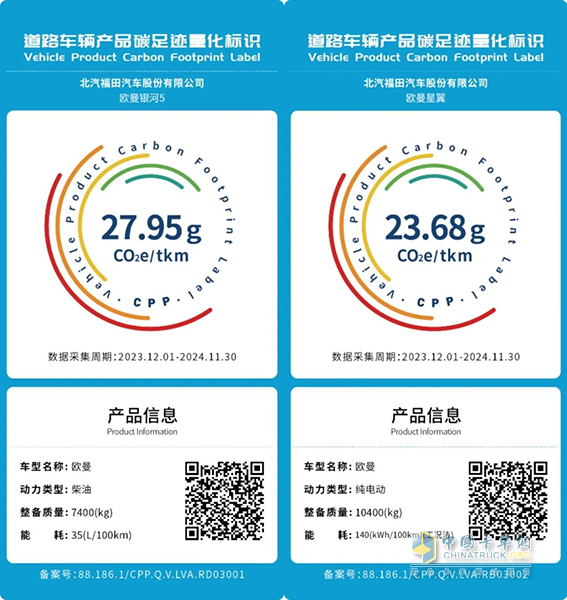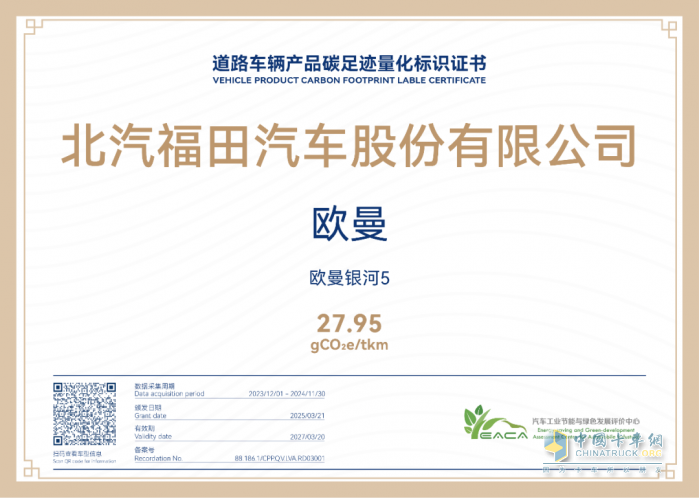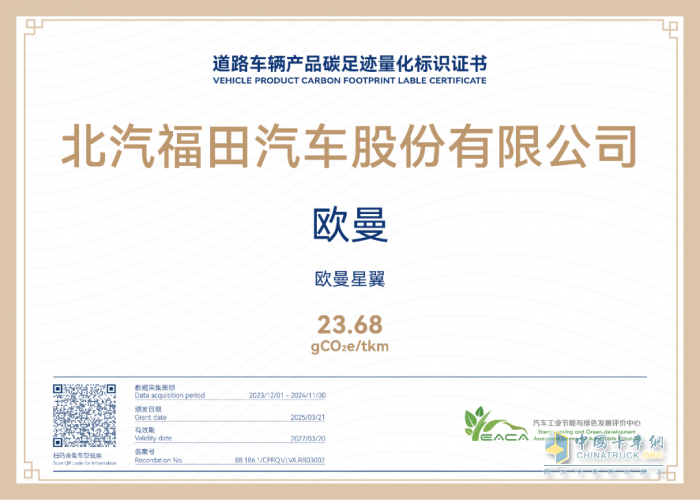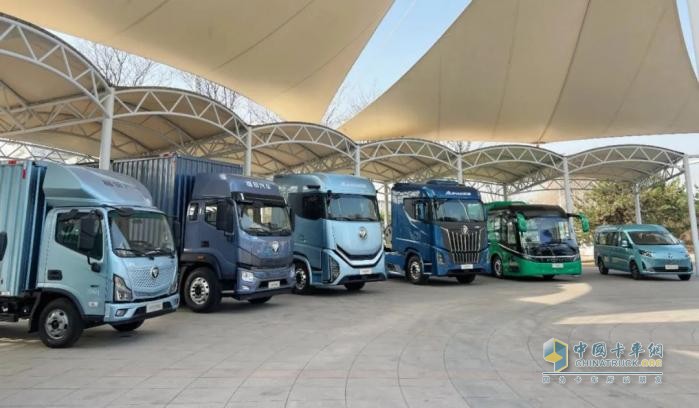Foton Motor Pioneers the "Carbon" Path - Two Heavy Trucks First Receive Carbon Footprint Quantification Labels
This year's Government Work Report proposed to jointly promote carbon reduction, pollution reduction, green expansion, and growth, and accelerate the comprehensive green transformation of economic and social development; actively and steadily promote carbon peaking and carbon neutrality, carry out carbon emission statistics and accounting, establish a product carbon footprint management system and a carbon label certification system, and actively respond to green trade barriers. In response to this, as one of the pillar industries of the national economy, the automotive industry has taken active actions and has always been at the forefront.
Driven by the "dual carbon" goals, nowadays, China's commercial vehicle industry is accelerating the pace of green transformation and gradually realizing the carbon footprint management of products throughout their life cycles. Recently, two heavy trucks of Foton Motor have passed strict reviews and obtained the carbon footprint quantification labels from the China Automotive Industry Chain Carbon Publicity Platform (CPP Platform). It is reported that this is another achievement of Foton Motor in the field of carbon footprint management and carbon reduction following the acquisition of carbon footprint quantification labels by four light truck models last year, and it is also the first batch of heavy truck models in the commercial vehicle industry to complete the carbon footprint quantification labels. This move demonstrates Foton Motor's determination to adhere to green and low-carbon development, and also reflects its firm implementation and continuous innovation of the new energy strategy.

Quantification Labels Make Carbon Reduction Traceable
The carbon footprint usually refers to the carbon emissions directly and indirectly generated by a specific object during its life cycle. The carbon footprint of a vehicle mainly includes the carbon emissions involved in four links: raw material acquisition, component and vehicle production, vehicle use, and vehicle scrap recycling. "The carbon footprint quantification label of the CPP Platform mainly targets the vehicle use link, and the carbon emission per ton-kilometer is a key indicator for measuring the carbon emission efficiency during the vehicle transportation process, indicating the carbon dioxide equivalent generated when transporting 1 ton of goods for 1 kilometer," introduced a relevant person in charge of Foton Motor. This label can help users understand the carbon emissions of products during use and guide the market competition to extend from the traditional "price-performance" dimension to the "low-carbon value" direction.

Carbon footprint management cannot be achieved without the joint efforts of upstream and downstream enterprises in the industrial chain. As a "pathfinder", Foton Motor is taking practical actions to drive more peer partners to join the carbon footprint management. It is reported that the heavy truck models of Foton Motor that obtained the carbon footprint quantification labels this time are the Auman Galaxy 5 fuel version and the Auman Xingyi pure electric version. Among them, the Auman Galaxy 5 is equipped with the Super Power Chain 5.0 and uses a new generation of ZF transmission exclusively. The transmission efficiency is as high as 99.7%, and the comprehensive energy consumption is 5% more fuel-efficient than similar products, with a carbon footprint of 27.95gCO2e/tkm. The carbon footprint of the other pure electric heavy truck, the Auman Xingyi, is relatively low, at 23.68gCO2e/tkm, that is, 23.68 grams of carbon dioxide are generated when transporting 1 ton of goods for 1 kilometer. "The peak power of the Auman Xingyi reaches 600 kilowatts, and the comprehensive energy consumption is reduced by more than 15%," introduced a relevant person in charge of Foton Motor. Its customized scenario control strategy makes the comprehensive operating condition energy consumption of the whole vehicle lower than 1.2 kilowatt-hours per kilometer, effectively reducing the operating cost.
The carbon footprint quantification label provides a common scale for the industry to measure the carbon emissions of heavy truck transportation, facilitating horizontal comparisons among different enterprises, different products, and different technical routes. "The lower the carbon emissions of a vehicle, the better its fuel economy or the more advanced its new energy technology, and long-term use will help reduce energy consumption costs," industry insiders believe. The carbon footprint quantification label directly reflects the energy efficiency and operating cost of heavy truck products, helping purchasers choose vehicles with higher cost performance and better environmental protection. At the same time, this indicator is also an important indicator for testing the fuel efficiency and emission level of products, and can guide commercial vehicle manufacturers to carry out technological innovation and optimization of product power systems, overall designs, etc.

"The carbon footprint quantification label will further enhance the competitiveness of Auman heavy trucks in the field of green commercial vehicles," introduced a relevant person in charge of Foton Motor. With the increase in environmental awareness in domestic and foreign markets, green and low-carbon products will be more valued, and products with carbon footprint data in particular will be more likely to be recognized by the market.
Improving Services to Boost the Promotion of New Energy Commercial Vehicles
New energy commercial vehicles play an important role in carbon reduction in the commercial vehicle industry and even in the transportation field. In recent years, the commercial vehicle industry represented by Foton Motor has continued to increase investment in the research and development of new energy technology products and actively promoted the popularization and application of new energy products.
"Over the years, Foton Motor has regarded the new energy strategy as its top development strategy, and currently has nearly a thousand products," introduced a relevant person in charge of Foton Motor. In 2024, Foton Motor once again emphasized "continuously accelerating the pace of new energy transformation", clearly stating that in the next three years, it will adhere to the three technical routes of "pure electric + hybrid + fuel cell" simultaneously, accelerate the layout of new energy core modules and key technologies, strengthen its independent research and development and manufacturing capabilities, and plans to achieve that the sales volume of new energy vehicles accounts for more than 50% by 2030.
In order to better promote the popularization and application of new energy commercial vehicles, Foton Motor will release an ESG report this year. "In the future, the market penetration rate of new energy commercial vehicles will be higher and higher. For enterprises to stand out from the fierce competition in the new energy track, they must do a good job in the after-sales service of new energy products," introduced a relevant person in charge of Foton Motor. While doing a good job in product technology research and development, Foton Motor is also actively laying out and improving the after-sales service network. It took the lead in carrying out new energy product services in Beijing in 2011, and currently has formed a new energy service network with nearly 2,000 stations.
In addition, Foton Motor is also carrying out in-depth cooperation with leading battery suppliers such as CATL, and improving its service capabilities based on its independent "three electric" core technologies. It is reported that Foton Motor has established 43 key service centers across the country, with the ability to open the "three electric" system for in-depth maintenance, which also reflects the differentiation of its services. In order to ensure the supply of accessories, Foton Motor has increased the reserve of new energy accessories by nearly 20 million yuan this year, further improving its service capabilities and better promoting the popularization and application of new energy commercial vehicles.

Carbon Reduction in Multiple Dimensions and the Whole Value Chain
The energy revolution is an important factor driving the development of the commercial vehicle industry. Over the years, Foton Motor has deeply analyzed the development trend of the industry, taken multiple measures simultaneously to reduce carbon emissions from the entire industrial chain including technology and products, and took the lead in laying out the enterprise's "dual carbon" goals: achieving carbon peaking in 2028, carbon neutrality in core factories in 2035, and carbon neutrality in the whole value chain in 2050.
"Currently, new energy commercial vehicles have accelerated into the main track, and it is expected that the sales volume will exceed 1 million in 2025, with a penetration rate of more than 30%," introduced a relevant person in charge of Foton Motor. Due to the complexity of usage scenarios, the coexistence of multiple technical routes for commercial vehicles will continue. It is expected that by 2030, traditional energy (including clean energy) commercial vehicles will account for about 50%, pure electric commercial vehicles will account for more than 30%, and both hybrid and hydrogen fuel commercial vehicles will exceed 10%.
Auman, a brand of Foton Motor, is one of the earliest brands in China to carry out the research and development of new energy heavy trucks. It adheres to the development of multiple technical routes on the new energy platform and meets the actual needs of new energy heavy truck users through in-depth customization in segmented scenarios. Over the years, Foton Motor has adhered to scientific and technological innovation as the guide, continuously increased investment in technology research and development in the fields of new energy, intelligence, lightweighting, etc., especially in cutting-edge technologies such as electrification and hydrogen fuel cells, and explored more efficient carbon reduction paths.
At the same time, Foton Motor has further improved the carbon footprint management system for the whole life cycle of products. From raw material procurement, production and manufacturing, logistics transportation to vehicle use and recycling, it comprehensively reduces carbon emissions. In terms of carbon reduction in the whole value chain, Foton Motor once proposed the "EPMES" dual carbon project and the carbon reduction technology roadmap, aiming to provide a practical path for achieving the "dual carbon" goals and promoting the company's sustainable development in the new energy field. A relevant person in charge of Foton Motor introduced that the "EPMES" dual carbon project starts from five dimensions: energy efficiency, product, manufacturing, ecology, and system, and implements a series of measures, covering photovoltaic power generation, low-carbon lightweight product design, green factory and supply chain construction, carbon asset management, and the construction of an energy and carbon management system, thus achieving coverage of the entire ecological link.

In the future, Foton Motor will continue to deepen the strategic layout of new energy, accelerate the research and development and application of new energy technologies such as pure electricity and hydrogen energy, create more low-carbon and intelligent commercial vehicle products, and provide consumers with more new choices for green travel.
The source of this news: chinatruck.org


